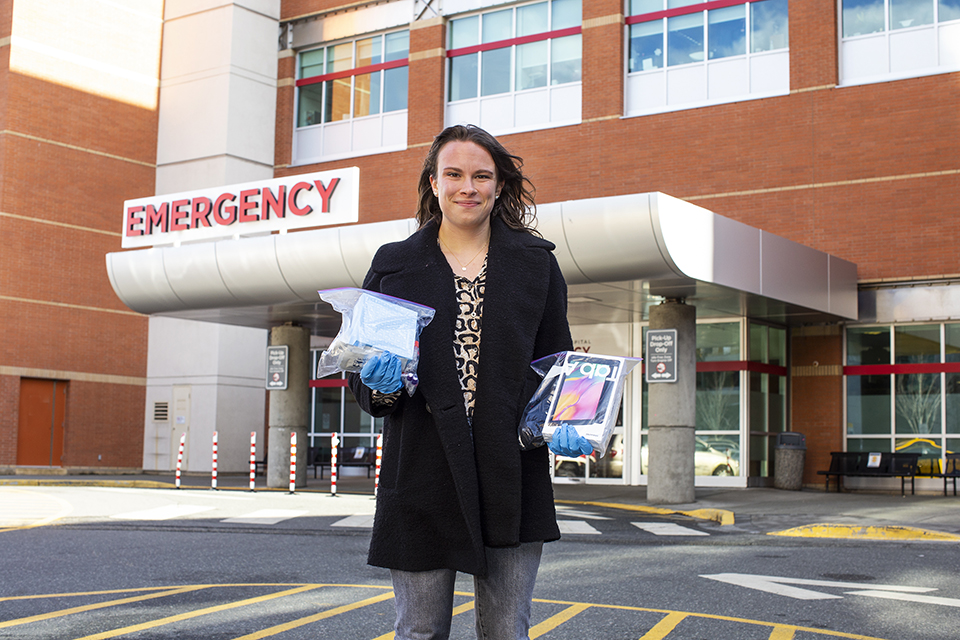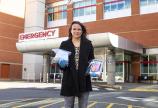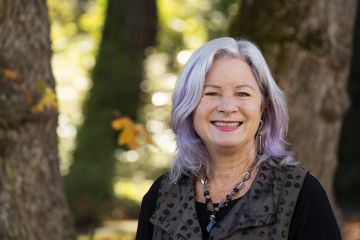Nurse study shows physical impacts of stress

Are those who carry the responsibility to keep us safe and healthy during a public health crisis staying healthy themselves? That’s the crux of a new University of Victoria research study looking at the physiological impacts of stress on Victoria-area hospital nurses.
The study, led by UVic graduate student Marisa Harrington, a Worksafe BC trainee award holder, and her supervisor Lynneth Stuart-Hill, is still in early days but results are already showing that participants’ stress responses are significant and similar, regardless of what department or hospital they’re working in.
The 10 nurses who have participated to date in Harrington’s ongoing study wore a watch-sized monitor over an eight-day shift rotation. Their sleep patterns were monitored, as were stress indices such as heart rate and heart rate variability.
“We’re still analyzing, but we are seeing significant data already, around sleep in particular,” says Harrington, an exercise physiology student working toward a master’s degree in the School of Exercise Science, Physical and Health Education. “These nurses are spending more time in light sleep and less in REM sleep as well as having less sleep overall. We’ve looked at the cardiovascular data and there is definitely an effect there as well.”
Preliminary data has indicated a reduction in heart rate variability, a marker of stress and a signal that the body’s sympathetic nervous system—responsible for our “fight, flight or freeze” response—is chronically dominating the parasympathetic nervous system, which keeps us calm.
In addition, the study is analyzing nurses’ saliva for three markers associated with stress, sleep and inflammation: cortisol, melatonin and interleukin-6. The latter is a cytokine, a protein related to the body’s immune response, now getting attention for the deadly “cytokine storms” that affect some people with COVID-19.
“We know that this is a population that feels stressed psychologically. Now, we’re establishing that there’s a measurable physiological impact as well,” says Harrington.
“I knew that my heart rate was always high on my shift, from beginning to end,” says Tasha Vollo-Crawford, study participant and a nurse at Royal Jubilee Hospital. “I see now that I’m in a constant state of stress at work.”
The study is part of broader research into the stress responses of shift workers being conducted by Stuart-Hill, an occupational physiologist and associate professor at UVic. Much of her research to date has involved male-dominated professions such as firefighting and logging, so Harrington’s research will help fill critical knowledge gaps in this under-researched occupation, says Stuart-Hill. She hopes to build on Harrington’s research findings through future studies of long-term care employees, paramedics and other community-based health care workers.
Phase two of Harrington’s study is now underway with a new round of study subjects. She anticipates concluding her work this spring.
The study is funded by UVic’s Centre for Occupational Research and Testing.
Read more in The Ring.
A media kit containing high-resolution photos is available on Dropbox.
*For interviews with Tasha Vollo-Crawford, please contact Suzanne Ahearne*
-- 30 --
Photos
Media contacts
Marisa Harrington (School of Exercise Science, Physical and Health Education) at marisaha@uvic.ca
Lynneth Stuart-Hill (School of Exercise Science, Physical and Health Education) at lstuhill@uvic.ca
Suzanne Ahearne (University Communications + Marketing) at 250-721-6139 or sahearne@uvic.ca
In this story
Keywords: COVID, health, research, community, administrative, student life
People: Marisa Harrington, Lynneth Stuart-Hill





